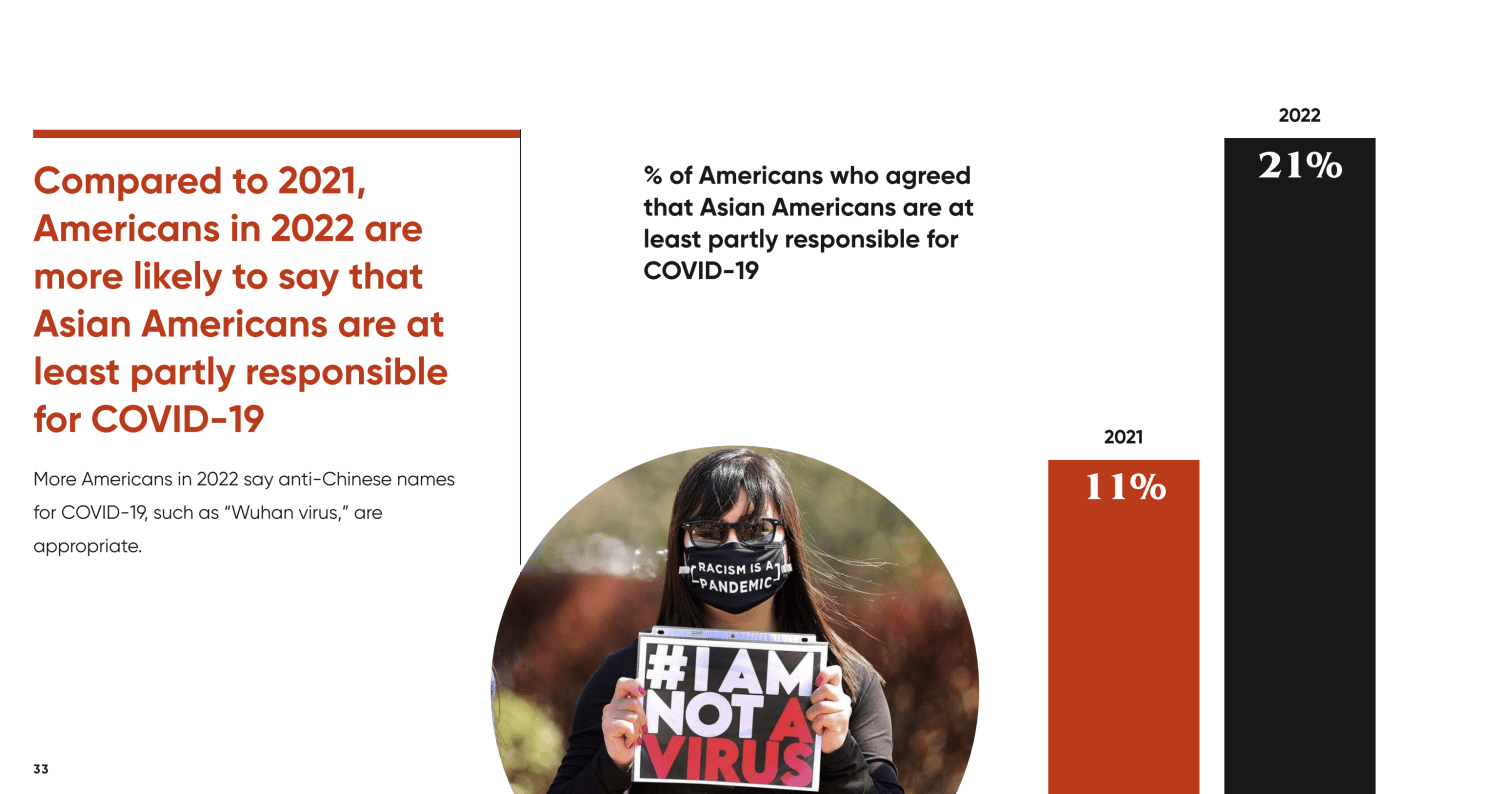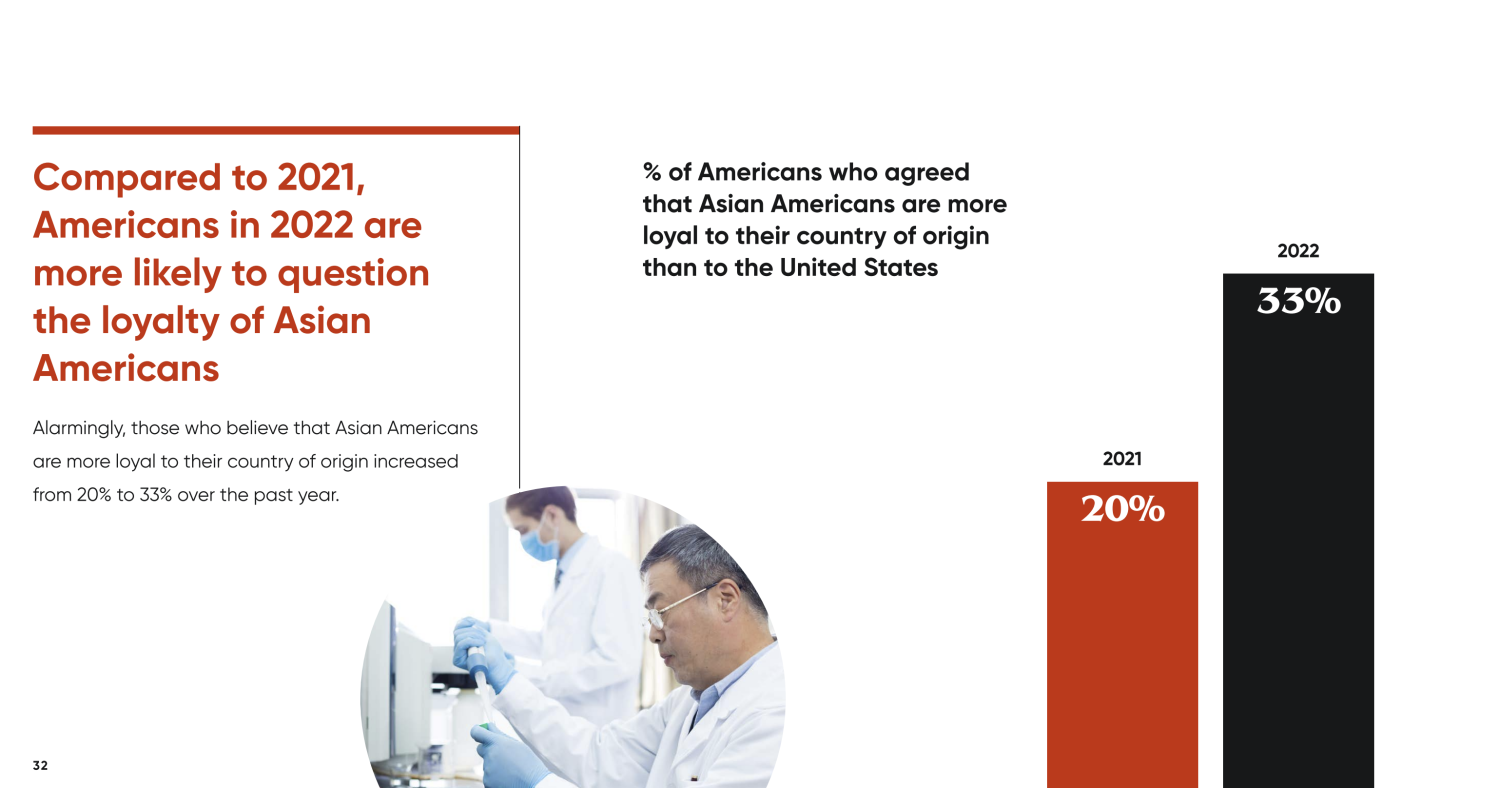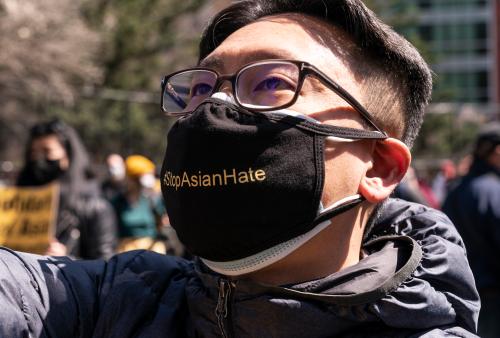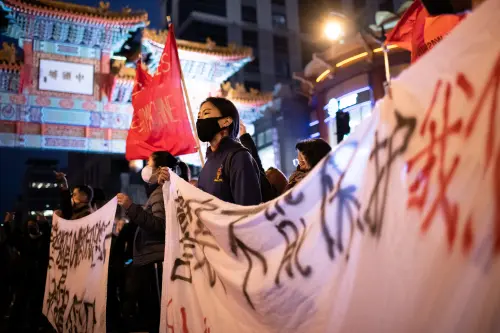Last week, a gunman opened fire in a Korean-owned hair salon in the Koreatown section of Dallas, Texas and shot three Korean women who suffered non-life-threatening injuries. The police are now investigating this as a hate crime that may be linked to two other shootings of Asian-owned businesses in the area. Anti-Asian violence and racism have surged since the Atlanta massacre last year that left eight dead—six of whom were Asian American women—but many Americans still fail to notice.
According to a national survey by AAPI Data and Momentive, anti-Asian hate crimes have increased since the start of the pandemic: 1 in 6 Asian American adults reported experiencing a hate crime in 2021, up from 1 in 8 in 2020. In the first three months of 2022, the figure has already reached 1 in 12. This trend may continue given the rise in anti-Asian racism.
The 2022 STAATUS Index shows that 1 in 5 Americans believe that Asian Americans are at least partly responsible for COVID-19 compared to 1 in 10 last year (see Figure 1). Americans are also now more likely to believe that referring to the coronavirus as “Chinese virus” and “Wuhan virus” is appropriate, and 1 in 3 believe that Asian Americans are more loyal to their country of origin than to the U.S., up from 1 in 5 in 2021 (see Figure 2).
In the past year alone, 1 in 10 Asian Americans have been coughed on or spit on, and nearly 1 in 3 have been told to “go back to your country.” In the previous administration, it was easy to blame Trump, but we are in a new administration, and racist attacks against Asians have increased. One-third of Americans, however, continue to remain unaware.
The invisibility of anti-Asian racism is a reflection of the invisibility of Asians in the American imagination: 58% of Americans cannot name a single prominent Asian American, and 42% cannot think of a historical experience or policy related to Asian Americans.
The invisibility is also glaring in funding priorities. Between 1992 and 2018, the National Institutes of Health invested only 0.17% of its budget on research on Asian Americans and Pacific Islanders. Foundations have not fared better: of the $19 billion awarded between 1983 and 1990, 0.18% was awarded to AAPI organizations, increasing to 0.20% by 2018. So for every $100 awarded by foundations, 20 cents was designated for AAPI communities.
Asian Americans also remain invisible in our school curricula: last year, Illinois became the first state to require that Asian American history be taught in public schools, and this year, New Jersey became the second. So should we really be surprised that 42% of Americans cannot name a single Asian American historical experience?
After seeing these survey results, I wondered whether I would have fared better had I not learned on my own. Despite having attended “the right schools,” I was never taught Asian American history, immigration, or race relations, nor did I learn about the legacy of anti-Asian violence, misogyny, activism, or Black-Asian solidarity in my courses. Since absence was the norm, it never occurred to me to request—let alone demand—a more diverse reading list. But now, as a faculty member, I realize the absurdity of the absence.
It would be inconceivable to teach a course on race without including African Americans, and unfathomable to teach immigration without including Latino immigration. Yet we have taught—and continue to teach—courses on race that fail to include Asian Americans even while Asians are the fastest-growing racial group in the country. We also teach courses on immigration that exclude Asian immigration even though Asian immigration has surpassed Latino immigration for more than a decade. Asians are the only group that is majority foreign-born, and Asian immigrants will outnumber Latino immigrants by 2055.
Apart from the country’s rapidly changing demographic landscape, as researchers, we should ask ourselves: What are we missing when we fail to include Asian Americans in our analyses?
A recent NBER paper serves as an example, in which the authors find that including Asian students in the sample changes the implications of their findings. First, they find that teachers rate Asian students more highly than white students with comparable standardized test scores even after adjusting for a host of demographic and behavioral measures. Second, they find that a single Asian student in a classroom amplifies teachers’ negative assessments of Black and Hispanic students relative to academically comparable white students, thereby widening the Black-white and Hispanic-white achievement gaps. Finally, they show that teachers’ positive bias towards Asian students is stronger than their negative bias towards Black students. Asians account for only 3% of their sample, yet including them in their analyses changes the inferences of the study’s results.
When we make the choice—and it is a choice—not to include Asian Americans in our research, we must ask ourselves what are we missing? What are we getting wrong? What message are we sending to our students? And how can we possibly understand the present moment of anti-Asian violence if we fail to understand and confront the past?
Thoughtfully including Asian Americans in our projects and in our courses will do more than make Asian Americans visible. It will assuage anti-Asian bias in our departments, our institutions, our disciplines, and will help disrupt the pernicious stereotypes that harm not only Asian Americans but also other people of color.
As Vice President Kamala Harris noted in her remarks at the White House reception to celebrate AANHPI Heritage Month, “Racism is real in America. It has always been. Xenophobia is real in America. It has always been.” The majority of Americans believe that anti-Asian racism is a problem that should be addressed, and have pointed to education as the solution. Teaching Asian Americans’ experiences in our pre-college curricula—alongside those of African Americans, Latino Americans, and Native Americans—will help educate all Americans about the fraught history of America, and guide us to a more just future.
I am committed to engaging in research that makes Asian Americans central to social science so that I am able to teach the type of courses that were never offered to me, and because I recognize the cost and consequence of failing to do so.
The Brookings Institution is committed to quality, independence, and impact.
We are supported by a diverse array of funders. In line with our values and policies, each Brookings publication represents the sole views of its author(s).









Commentary
Confronting the invisibility of anti-Asian racism
May 18, 2022